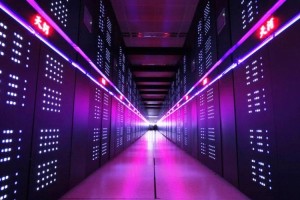 Once a seething cauldron of competition, the twice-yearly Top500 listing of the world’s most powerful supercomputers has grown nearly stagnant of late.
Once a seething cauldron of competition, the twice-yearly Top500 listing of the world’s most powerful supercomputers has grown nearly stagnant of late.In the most recent Top500 compilation, released Monday, the Chinese National University of Defense Technology’s Tianhe-2 has retained its position as the world’s fastest system, for the fourth time in a row.
Tianhe-2 is no more powerful than when it debuted atop the Top500 in June 2013; in a Linpack benchmark, it offered 33.86 petaflop/s of computing power. A petaflop is one quadrillion floating point operations.
Only one new entrant debuted in the top 10 in this Top500 – a system built by Cray for an unnamed U.S. government agency, which brought 3.57 petaflop/s to the table.
The organizers of the Top500 – volunteers from Lawrence Berkeley National Laboratory. the University of Tennessee, and supercomputer conference organiser Prometeus – did not speculate as to why advancement in supercomputing performance, at least by how they measure it, is slowing. They plan to offer an analysis Tuesday at the SC14 supercomputing conference in New Orleans.
But factors could include decreased government research spending and the emergence of supercomputing-scaled services from cloud providers such as Amazon and Microsoft, which don’t require large up-front capital costs to install a giant machine on premises.
The organisers did note that the lack of competition at the top of the chart is slowing advancement of the list overall.
Typically, the fasted computers on one list will slowly work their way down in the ranking for successive lists, as they are topped by even faster computers, they explained. As a result, the aggregated performance of all the computers has, historically, improved. Such trickle-down improvements seem to be slowing. Between 1994 and 2008, the annual performance growth rate was 90 percent, but for the past five years, it has been 55 percent.
Total combined performance of all 500 systems in the latest list amounts to 309 Pflop/s, compared to 274 Pflop/s in June and 250 Pflop/s a year ago.
The U.S. Department of Energy may shake things up in the years to come, however. The agency, which funds supercomputers for scientific research, is ramping up a plan to build a 300 petaflop computer and have it running as early as 2017, pending funding from Congress.
The U.S. continues to have the most systems on the current list, though that number has decreased to historic lows, with 231 systems on the current list, down from 233 in June 2014 and 265 on the November 2013 list. Asian systems also dropped in number, to 120, down from 132 in June. Europe, on the other hand, has been growing its supercomputing presence. Europeans now have 130 systems on the list, up from 116 in June.
In terms of system providers, Hewlett-Packard is the most dominant with 179 systems or about 36 percent of the list overall. Following close behind is IBM with 153 systems, 30 percent of the list overall. Dedicated supercomputer builder Cray comes in third, with 62 systems or 12.4 percent.





